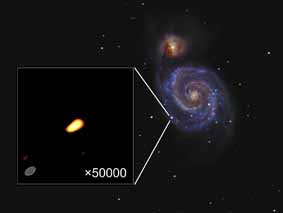
An international team of astronomers, led by the Valencian Iván Martí Vidal, obtains an ever achieved radio astronomical photograph of the youngest supernova. Fourteen days after the explosion of a star in the galaxy Galàxia del Remolí (M51) last June, coordinated telescopes around Europe have taken a photograph of the cosmic explosion with great detail –it would mean to see a golf ball on the surface of the moon.
The University of Valencia and the Institute of Astrophysics of Andalusia take part in this research. The results will be published this week in the journal Astronomy & Astrophysics. The telescopes participating in the research were NASA’s telescopes at Robledo de Chavela (Madrid) and those of the National Geographic Institute in Yebes (Guadalajara).
Barely at 23 million light years from the Earth, in the constellation of Llebrers, Galàxia El Remolí can be the scene of one of the most violent phenomena in the universe, despite its beautiful appearance: the death of a star in the shape of a supernova explosion. Several combined telescopes spread over Spain, Sweden, Germay and Finland, and the data processing by means of a supercomputer in The Netherlands, enable to have the capacity of a telescope measuring thousands of kilometres. Thus, a really clear image has been obtained, with a detail a hundred times greater than that of the space telescope Hubble. This technique, known as radio interferometry, has allowed Iván Martí and his team to take a photograph of the supernovova SN2011dh just some days after its explosion.
This experiment is beating a record: ‘this is the earliest high resolution image of a supernova explosion. From this photograph, we can define the expansion velocity of the shock wave created in the explosion’, states Iván Martí from the Institut Max Planck of Radio Astronomy in Bonn (Germany). The full professor in Astronomy and Astrophysics from the University of Valencia, Jon Marcaid, argues that ‘with this precision, we can look for the previous star on the earlier galaxy photographs, as well as weigh up better our future observations.’
Supernovas are one of the most spectacular phenomena in the universe. Antxon Alberdi, from the Institute of Astrophysics of Andalusia states that ‘if we are lucky, like we were this time, we can obtain really clear and high resolution images of the supernovas, thanks to the VLBI technique (Very Long Baseline Interferometry).’
The international team that achieved this photograph is already working on new observations. The European VLBI network is a collaboration of radio astronomy institutes around Europe, China and South Africa, and sponsored by the respective national research bodies.
More information:
Original publishing: VLBI Observations of SN2011dh: Imaging of the youngest radio supernova, by I. Martí-Vidal and collaborators, Astronomy and Astrophysics (2011), http://dx.doi.org/10.1051/0004-6361/201118195
Last update: 24 de november de 2011 07:31.
News release



















